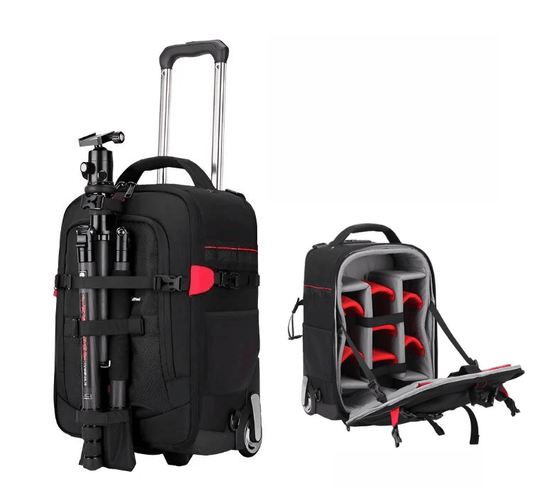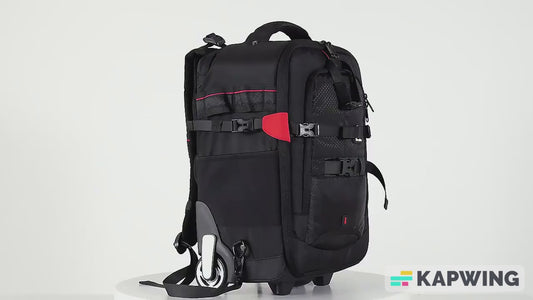The Ultimate Packing Guide for Your California Camping Road Trip Adventure
Imagine waking up to the sound of crashing waves, surrounded by towering redwoods, and embarking on a journey through diverse landscapes. A California road trip with camping stops offers the perfect blend of adventure, nature, and exploration. Whether you're a seasoned camper or a first-time adventurer, this ultimate packing guide will ensure you're fully prepared for an unforgettable California road trip with camping experiences.
The Rise of Camping Road Trips in California
Camping and road trips have long been ingrained in California's cultural fabric, with iconic routes like the Pacific Coast Highway drawing travelers for decades. However, recent years have seen a significant surge in interest, particularly in the wake of the global pandemic. As people seek deeper connections with nature and more meaningful travel experiences, camping road trips have emerged as a popular choice.
According to recent data from Pitchup.com, there's been a remarkable increase in outdoor travel interest. In 2024, the platform recorded over 443,000 searches for farm campgrounds, indicating a growing trend towards agritourism and nature-based experiences. This surge in popularity is further evidenced by Pitchup.com marking its five millionth booking in 2024.
"This year's record bookings on Pitchup.com show continued interest in outdoor immersion, which offers a meaningful way for people to find balance and forge deeper connections with themselves and their surroundings"
Dan Yates, Founder and Managing Director of Pitchup.com
This statement underscores the current significance of camping road trips as a means of reconnecting with nature and finding personal equilibrium.
Planning Your California Road Trip
Choosing Your Route
When planning your California camping road trip, the first step is selecting your route. The Pacific Coast Highway remains a popular choice, offering stunning coastal views and access to numerous camping spots. However, consider alternatives that cater to your interests and desired camping experiences.
A sample itinerary might include:
- Starting in San Francisco
- Driving south along the Pacific Coast Highway
- Stopping at Big Sur for camping and hiking
- Exploring Monterey and its famous aquarium
- Camping near Cambria and visiting Hearst Castle
- Ending the trip in Los Angeles
This route offers a mix of urban exploration, natural wonders, and diverse camping opportunities.
Selecting Campsites
California boasts an array of camping options, from state and national parks to private campgrounds. When choosing your campsites, consider the following:
- State and National Parks: These often offer the most pristine natural settings and well-maintained facilities. Popular options include Julia Pfeiffer Burns State Park in Big Sur and Pfeiffer Big Sur State Park.
- Private Campgrounds: These may offer more amenities and are often easier to book, especially during peak seasons.
- Booking in Advance vs. Spontaneous Camping: While spontaneity can add excitement to your trip, booking in advance is highly recommended, especially during peak seasons. Many popular campsites fill up months in advance.
It's worth noting that camping fees have been on the rise due to inflation and dynamic pricing. As of December 2024, experts predict that camping fees will continue to increase in 2025, with some nightly fees exceeding $70. Budget accordingly and consider camping during off-peak times for better rates.
Essential Gear for Camping in California
The 10 Essentials
When packing for your California camping road trip, start with the 10 Essentials:
- Backpack with waist straps: Choose a comfortable, well-fitting backpack for day hikes and short excursions.
- Sun protection: California's sunshine is abundant, so pack sunscreen, lip balm with SPF, a wide-brimmed hat, and sunglasses.
- Insulation: Even in summer, nights can be cool. Pack layers including a jacket, vest, pants, gloves, and a warm hat.
- Illumination: Bring a headlamp or flashlight with extra batteries for navigating campsites after dark.
- First-aid supplies: Pack a comprehensive first-aid kit, including any personal medications.
- Fire starters: Bring waterproof matches or a lighter in a waterproof container. Check local fire regulations before starting any campfires.
- Repair kit: Include a multi-tool, duct tape, and any specific repair items for your gear.
- Nutrition: Pack more food than you think you'll need, focusing on high-energy, non-perishable items.
- Hydration: Bring water bottles or hydration reservoirs, and a reliable water filter or purification system.
- Shelter: A tent, tarp, or bivy sack is essential for overnight stays.
Camp Kitchen Basics
For a comfortable camping experience, include these camp kitchen essentials:
- Water bottles
- Plates, bowls, and utensils (consider eco-friendly, reusable options)
- Mugs/cups
- Matches/lighter
- Dehydrated food options
- Snacks
- Portable stove and fuel (if allowed at your campsites)
- Cooler for perishables
Newest Relevant Tools/Equipment
As camping technology evolves, consider these modern additions to your gear:
- Advanced Water Filters: Lightweight, efficient filters like the LifeStraw or Sawyer Mini ensure safe drinking water from various sources.
- Solar and Portable Power: Solar chargers and portable power banks keep your devices charged in remote areas.
- Navigation Tools: While traditional maps and compasses are still essential, consider GPS devices or smartphone apps designed for offline use in wilderness areas.
Emerging Trends in California Camping
Agritourism and Naturist Experiences
One of the fastest-growing trends in California camping is agritourism. This involves camping on working farms or ranches, offering a unique blend of outdoor adventure and agricultural experience. Visitors can often participate in farm activities, learn about sustainable agriculture, and enjoy farm-to-table dining experiences.
Luxury Glamping Options
For those seeking a more comfortable outdoor experience, luxury glamping options are on the rise. These accommodations often feature amenities like comfortable beds, private bathrooms, and gourmet dining options, all while maintaining a connection to nature.
Sustainable Camping Practices
With growing environmental concerns, there's an increasing focus on sustainable camping practices. This includes using eco-friendly gear, minimizing waste, and adhering to Leave No Trace principles. Many campgrounds are also implementing sustainability initiatives, such as solar power and water conservation measures.
Impact of Recent Developments
Economic Impact
The camping industry in California is experiencing significant economic shifts:
- Rising Camping Fees: Due to inflation and dynamic pricing, camping fees are increasing. As of December 2024, experts predict nightly fees at many private campgrounds to exceed $70 in 2025.
- Increased Demand for Luxury Experiences: The growing popularity of glamping and high-end outdoor experiences is creating new revenue streams within the camping industry.
Environmental Impact
The surge in camping's popularity has led to increased focus on environmental conservation:
- Growing Need for Sustainable Practices: Campgrounds and campers alike are adopting more eco-friendly approaches to minimize environmental impact.
- Balancing Increased Tourism with Conservation: Parks and camping areas are working to manage the influx of visitors while preserving natural habitats and ecosystems.
Comparison of Camping Options
| Option | Pros | Cons | Cost | Best For |
|---|---|---|---|---|
| Tent Camping |
|
|
$-$$ | Nature enthusiasts, budget travelers |
| RV Camping |
|
|
$$-$$$ | Families, long-term travelers, comfort seekers |
| Hotel Stays |
|
|
$$$-$$$$ | Luxury travelers, those seeking comfort |
Current Controversies and Challenges
California Clean Air Regulation Impact on RV Sales
A recent controversy in the camping world involves California's Clean Air Regulation, which has threatened the sales of new large motor homes in California and five other states. This regulation aims to reduce emissions but has caused concern within the RV community about the future availability and cost of large RVs.
Rising Camping Fees and Accessibility Concerns
The significant increase in camping fees, driven by inflation and dynamic pricing, has raised concerns about the accessibility of camping experiences. Some worry that higher costs may price out certain demographics, potentially limiting the diversity of campers.
Infrastructure Repairs and Campsite Closures
Many state and national parks are facing challenges related to aging infrastructure. In 2025, several parks are expected to undergo repairs and upgrades, which may result in temporary campsite closures or limited availability. Campers should be prepared for potential disruptions and plan accordingly.
How To: Maximize Your California Camping Road Trip Experience
Planning Your Itinerary
- Balance driving time and exploration: Aim for no more than 3-4 hours of driving per day to allow ample time for sightseeing and camping activities.
- Incorporate diverse landscapes: California offers a variety of ecosystems. Try to include coastal, mountain, and desert experiences in your itinerary.
- Plan for flexibility: Leave room in your schedule for spontaneous discoveries or extended stays at favorite spots.
Campsite Etiquette and Best Practices
-
Follow Leave No Trace principles:
- Pack out all trash
- Stay on designated trails
- Respect wildlife by maintaining a safe distance
- Minimize campfire impacts
- Respect quiet hours: Most campgrounds have designated quiet hours, typically from 10 PM to 6 AM.
- Be a good neighbor: Keep your campsite clean and respect the space of nearby campers.
Optimizing Your Vehicle for a Camping Road Trip
-
Storage solutions:
- Use roof racks or cargo boxes for extra storage
- Invest in organizers for the car interior to keep gear easily accessible
- Consider a hitch-mounted cargo carrier for additional space
-
Vehicle maintenance tips:
- Get a full service before your trip
- Check tire pressure regularly, including the spare
- Carry basic tools and know how to change a tire
- Keep an emergency kit in the vehicle
FAQ Section
What are the best times of year for a California camping road trip?
California's diverse climate means there's no single "best" time for a camping road trip. However, here's a seasonal breakdown:
- Spring (March-May): Mild temperatures and wildflower blooms make this an excellent time for camping, especially in desert areas.
- Summer (June-August): Ideal for coastal and mountain camping, but expect crowds and higher prices. Inland areas can be very hot.
- Fall (September-November): Pleasant temperatures and fewer crowds make this a great time for camping throughout the state.
- Winter (December-February): Coastal areas remain mild, while mountain regions offer snow camping opportunities. Some campgrounds may close for the season.
How can I find last-minute camping spots during peak season?
Finding last-minute spots during peak season can be challenging but not impossible:
- Use apps like Hipcamp or The Dyrt to find and book available sites.
- Check for cancellations at popular campgrounds early in the morning.
- Consider less popular or more remote campgrounds.
- Look for dispersed camping options on Bureau of Land Management (BLM) or National Forest land.
- Some campgrounds keep a portion of their sites for first-come, first-served campers. Arrive early to secure these spots.
What are California's regulations on campfires and fire safety?
California's fire regulations can vary depending on location and current conditions:
- Check current fire restrictions before your trip. During high fire danger periods, campfires may be completely banned.
- When allowed, build fires only in designated fire rings or pits.
- Keep fires small and manageable.
- Never leave a fire unattended and fully extinguish it before leaving your campsite or going to sleep.
- In some areas, you may need a campfire permit, which can often be obtained online for free.
Always prioritize fire safety and be prepared to adapt your plans if fire restrictions are in place.
Success Stories
The Johnson Family's Pacific Coast Highway Adventure
The Johnson family, consisting of parents Mark and Sarah and their two children, Emma (12) and Ethan (9), embarked on a 10-day camping road trip along the Pacific Coast Highway in the summer of 2024. Their journey began in San Francisco and ended in Los Angeles, with several memorable stops along the way.
Highlights of their trip included:
- Camping at Half Moon Bay State Beach, where they enjoyed beachcombing and watched a spectacular sunset.
- Exploring tide pools and hiking in Point Lobos State Natural Reserve near Carmel.
- Spending two nights in Big Sur, where they camped at Pfeiffer Big Sur State Park and hiked to McWay Falls.
- Visiting the Monterey Bay Aquarium and camping at nearby Veterans Memorial Park.
- Exploring Hearst Castle and camping at San Simeon State Park.
- Ending their trip with a night of glamping in Santa Barbara.
"Our California camping road trip was the perfect blend of adventure and family bonding. We were amazed by the diverse landscapes and the incredible camping experiences. The kids learned so much about nature and conservation, and we created memories that will last a lifetime."
Sarah Johnson
Expert Insights: John Martinez, California State Parks Ranger
John Martinez, a veteran California State Parks Ranger with over 20 years of experience, offers valuable insights for campers planning a road trip:
"California's state parks offer some of the most diverse and beautiful camping experiences in the world. To make the most of your trip, I recommend:
- Reserving early: Popular campgrounds can book up months in advance, especially for summer weekends.
- Exploring lesser-known parks: While places like Yosemite are incredible, don't overlook smaller, less crowded parks that offer equally stunning experiences.
- Being prepared for microclimates: California's weather can vary dramatically even within short distances. Layer your clothing and be ready for changes.
- Participating in ranger programs: Many parks offer educational programs that can enrich your understanding of the local ecosystem and history.
- Practicing fire safety: Always check current fire regulations and never leave a campfire unattended.
Remember, the goal is not just to visit these beautiful places, but to help preserve them for future generations."
John Martinez, California State Parks Ranger
Conclusion
Embarking on a California camping road trip is more than just a vacation; it's an opportunity to connect with nature, explore diverse landscapes, and create lasting memories. By following this comprehensive guide, you'll be well-prepared to navigate the challenges and embrace the joys of outdoor adventure in the Golden State.
Key takeaways for a successful California camping road trip include:
- Thorough planning: Research your route, book campsites in advance, and prepare for various weather conditions.
- Essential packing: Bring the right gear, focusing on the 10 Essentials and camping-specific items.
- Flexibility: Be prepared to adapt your plans due to weather, campsite availability, or unexpected discoveries.
- Responsible camping: Practice Leave No Trace principles and respect the natural environment and local communities.
- Embrace the experience: Take time to immerse yourself in the diverse landscapes and unique experiences California has to offer.
As you set out on your journey, remember that the true value of a camping road trip lies not just in the destinations you reach, but in the experiences you gather along the way. From the towering redwoods to the crashing waves of the Pacific, from serene desert nights to misty mountain mornings, California's natural wonders await your exploration.
So pack your gear, chart your course, and prepare for an unforgettable adventure. The open road and California's breathtaking landscapes are calling – it's time to answer and create your own story of exploration and discovery.
Additional Resources
To further assist in planning your California camping road trip, here are some valuable resources:
-
California State Parks Website: parks.ca.gov
- Official information on state park campgrounds, reservations, and current conditions.
-
National Park Service - California: nps.gov/state/ca
- Details on national parks in California, including camping information and park-specific regulations.
-
Recreation.gov: recreation.gov
- Centralized booking platform for campsites in national parks, national forests, and other federal lands.
-
Hipcamp: hipcamp.com
- Platform for finding and booking unique camping experiences, including private land camping options.
-
AllTrails: alltrails.com
- Comprehensive database of hiking trails with user reviews and difficulty ratings.
-
California Road Trip Republic: visitcalifornia.com/experience/road-trips
- Official California tourism website with road trip itineraries and travel inspiration.
-
iOverlander App: Available on iOS and Android
- User-generated database of campsites, including free and dispersed camping options.
-
Campendium: campendium.com
- Website and app with campground reviews, photos, and information on amenities.
-
California Camping by Tom Stienstra (Book)
- Comprehensive guidebook covering over 1,400 camping options in California.
-
Moon California Camping: The Complete Guide to Tent and RV Camping (Book)
- Detailed guide with campground maps, facilities information, and suggested itineraries.
These resources will provide you with up-to-date information on campsites, trails, and local attractions, helping you plan a safe and enjoyable California camping road trip. Remember to check for the most current editions of guidebooks and verify any information online, as details can change from season to season.
By utilizing these resources and following the comprehensive guide provided in this blog post, you'll be well-equipped to embark on an unforgettable California camping road trip adventure. Happy camping and safe travels!































































